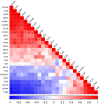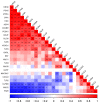Exploring the Differential Expression of a Set of Key Genes Involved in the Regulation and Functioning of the Stomach in the Post-Weaned Pig
- PMID: 37505877
- PMCID: PMC10386345
- DOI: 10.3390/vetsci10070473
Exploring the Differential Expression of a Set of Key Genes Involved in the Regulation and Functioning of the Stomach in the Post-Weaned Pig
Abstract
Despite playing a key role in digestion, there is only a broad characterization of the spatiotemporal development of the three glandular regions of the stomach (cardiac, fundic and pyloric) in the weaned pig. Hence, the objective of this experiment was to explore the differential expression (DE) of a panel of key genes within the three glandular regions of the stomach. Eight pigs were sacrificed at d 8 post-weaning, and three mucosal samples were collected from each stomach's glandular regions. The expression of a panel of genes were measured using QPCR. The true cardiac gland region was characterized by increased expression of PIGR, OLFM4, CXCL8 and MUC2 relative to the two other regions (p < 0.05). The fundic gland region was characterized by increased expression of ATP4A, CLIC6, KCNQ1, HRH2, AQP4, HDC, CCKBR, CHIA, PGA5, GHRL and MBOAT4 compared to the two other regions (p < 0.05). The pyloric gland region was characterized by exclusive expression of GAST (p < 0.05). A transition region between the cardiac and fundic region (cardiac-to-oxyntic transition) was observed with a gene expression signature that resembles a cross of the signatures found in the two regions. In conclusion, unique gene expression signatures were identifiable in each of the glandular regions, with a cardiac-to-oxyntic transition region clearly identifiable in the post-weaned pigs' stomachs.
Keywords: acid secretion; cardiac gland region; cardiac-to-oxyntic transition; fundic gland region; glandular regions; monogastric; pyloric gland region.
Conflict of interest statement
The authors declare no conflict of interest.
Figures





References
-
- Du G.M., Shi Z.M., Wei X.H., Liu M.J., Zhang L., Zhao R.Q. Expression of gastric ghrelin and H+–K+-ATPase MRNA in weanling piglets and effect of ghrelin on H+–K+-ATPase expression and activity in gastric mucosal cells in vitro. Res. Vet. Sci. 2007;82:99–104. doi: 10.1016/j.rvsc.2006.06.004. - DOI - PubMed
Grants and funding
LinkOut - more resources
Full Text Sources
Miscellaneous

